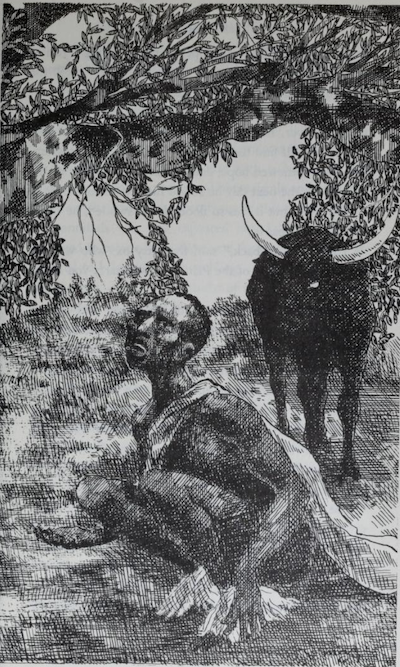The book's dedication explains the idea behind the book very clearly: "This was book done especially for the Black Children who have never read black fairy tales." Although it is now an old book (over 50 years old in fact!), it was included with a favorable review in this very useful project: Annotated Selected Bibliography and Index for Teaching African-American Learners: Culturally Responsive Pedagogy Project by Asa Hilliard, a massive 750-page project published in 1997, and available at Internet Archive too.
There are ten stories in the book, along with a very useful glossary in back for unfamiliar words like calabash and ochre along with words that are not (American) English like assegai or kaross.
One of the best features of the book is the beautiful artwork by David Omar White, full of drama and detail. Here are just a few of the illustrations:
I haven't been able to find out much about Terry Berger, but the artist was quite well known; you can see more of his work at his website (he died in 2009).
What makes this book especially useful is that the stories here were selected and retold from a book now in the public domain: Fairy Tales from South Africa by Mrs. E. J. Bourhill and Mrs. J. B. Drake, published in 1908 and also available at the Internet Archive. That book contains 20 stories; Berger selected 10 of those stories to retell.
There are illustrations by W. Herbert Holloway, but they do not begin to compare in quality with the great artwork in Berger's book, although they are useful in adding some drama and depth to the text. For example, this illustration shows birds carrying a princess away up into the sky:
There are lots of picture books and chapter books for children based on retelling a single story from an old source. This book is unusual in that it is a collection of longer, more elaborate stories for older readers, and it is very much needed because Bourhill and Drake's book is not one you could share with young readers today. As is typical with books of that time, the stories recorded there are of great value, but the commentary from the authors is deeply racist and condescending, going on about "Kafirs" (e.g. "The Kafir people still live and flourish in this country. They no longer make war on one another, for the white people oblige them to live in peace") in a way that makes the book unusable for young readers today, even though the book was written for a young (white) audience of 100 years ago. By writing the stories in a book explicitly for young Black readers, Terry Berger has done us a great service, and we need many more books like this, freeing the stories and storytellers from the old books which frame the stories in deeply wrong ways.
So, if you are looking for a book to share with young readers, take a look at Berger's Black Fairy Tales. Meanwhile, if you are in search of stories and ready for the racist framing, you will find even more stories in Bourhill and Drake's book too; just brace yourself for the colonial context and use your imagination to bring to life the storytellers freed from the racist perceptions of the authors.
by Terry Berger
by Mrs. E. J. Bourhill and Mrs. J. B. Drake








No comments:
Post a Comment
Comments are limited to Google accounts. You can also email me at laurakgibbs@gmail.com or find me at Twitter, @OnlineCrsLady.